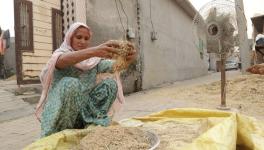Govt’s Bid to Divide NREGA Wages into SC/ST/Others Categories May Affect Timely Payment

Image Courtesy: Business Today
On March 2 this year, without any consultation and without explaining the rationale behind it, the Union Ministry of Rural Development issued an advisory to all states and union territories seeking division of wage payments under the Mahatma Gandhi National Rural Employment Guarantee Act (MGNREGA) under different categories – Scheduled Castes, Scheduled Tribes and others.
NREGA Sangharsh Morcha, an umbrella group of organisations and individuals from across the country, has objected to this division of workers and written to Rural Development Minister Narendra Tomar demanding that this “advisory” be withdrawn with immediate effect.
It makes no sense at all to divide workers who are all entitled to the same wages into such categories, and each time the payment modality has been changed in the past, workers have borne the brunt with delayed wage payment, having to face “teething troubles” in the system of disbursement. Even now, 12 years after the introduction of direct payment into bank accounts rather than at work sites, wages are never paid 15 days after the work is completed, as required under the law. “The need of the hour is not to complicate the payment system yet again, but simplify it and ensure timely and reliable wage payments,” the Morcha said in a letter to the minister.
Debmalya Nandy of the NREGA Sangharsh Morcha said, “I see no benefit from this move, except to make an already complex payment procedure even more complex. The planning process for this scheme must be led by the gram sabha. Already, payments are being held up for about a month.”
While the Rural Development Ministry maintains disaggregated data on the number of SC/ST/women employed under the scheme, the payment modality is the same for all, and researchers can access disaggregated data through the MGNREGA website.
Nisar Ahmed of the Budget Analysis Research Centre in Rajasthan said, “The ministry can maintain disaggregated data for research purposes, and to plan policies. However, I do not understand the need to introduce a payment modality that makes for categorywise distinction. It will only delay payment and affect workers adversely.”
The Scheduled Caste and Scheduled Tribe Sub Plans were introduced in the 1970s under the aegis of the Planning Commission to facilitate the development of communities that were lagging behind, in accordance with the proportion of the population these groups represented. In 2006, to ensure that these funds were not diverted for other purposes, the Union government declared that these allocations would be non-lapsable and non-divertable. However, this arrangement crumbled when plan and non-plan budgets were collapsed in 2017-18.
In any case, the government spending on SC and ST groups have consistently fallen short of the actual need. National Campaign on Dalit Human Rights conducted an analysis about two years ago based on budget estimates for Dalits and Adivasis. It calculated the required allocation on the basis of policy guidelines between 2014 and 2019. It found that the required amount for this period was Rs 6.2 lakh crore for SCs while the government allocation was only Rs 3.1 lakh crore, half the required amount. SCs comprise about 16% of the total population, but only 8% of central sector schemes or centrally sponsored schemes were allocated to this category.
For Scheduled Tribes, the required allocation was Rs 3.28 lakh crore between 2014-19, and actual government allocation was Rs 2 lakh crore, just about 60% of the requirement. The ST population is about 8% of India’s total population, and the allocation for them was just over 5% of the total outlay. Even after this meagre allocation, the actual spending was very low.
One advantage the government might have from dividing up NREGA payments category wise would be to claim higher spending for SC/ST groups.
Under Budget 2021, Rs 73,000 crore was allocated to MGNREA; in the previous year, Rs 61,500 crore had been allocated to it; in August 2020, after the mass exodus of workers from urban centres and increased demand for work in villages, Rs 40,000 crore was additionally released under NREGA. So, the combined allocation for NREGA in the 2021 budget is substantially lesser than the allocation in the previous year, even though regional lockdowns have continued and unemployment risen to 14% in May 2021.
In just two months of the current financial year, over 36,000 households have completed the 100 days of employment they are allowed under this scheme. In 2020-21, a total of 72 lakh households completed 100 days of work under the scheme, at an average of Rs 200 per day. In early 2021, there were reports that workers were getting by with employment under MGNREGA when other options had closed.
It may be pertinent to recall that in February 2015, speaking in Parliament, Prime Minister Narendra Modi said it was a mark of his political acumen that he would keep MGNREGA alive – the scheme was a constant reminder, he said, of the failure of the Congress party, which continued to make poor people dig ditches so long after independence.
Congress leader Mani Shankar Aiyar opposed the advisory and said, “I would like to endorse the letter of protest in my capacity as India’s first Union Minister of Panchayati Raj, who was present at the creation of the MGNREGA.”
NN Sinha, secretary, Union Rural Development Ministry, was busy in a video conference and could not respond when this reporter called. This report will be updated if a response is received about the rationale for this advisory.
Get the latest reports & analysis with people's perspective on Protests, movements & deep analytical videos, discussions of the current affairs in your Telegram app. Subscribe to NewsClick's Telegram channel & get Real-Time updates on stories, as they get published on our website.
























